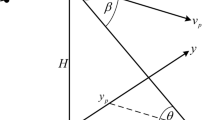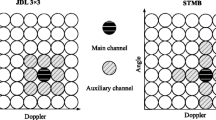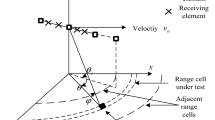Abstract
In static radars, all the ground returns are received with a Doppler frequency almost null. However, in airborne radars, they present a wide spectrum for the Doppler frequencies because of the platform in motion. Space-time adaptive processing (STAP) was introduced to improve the capacity of radars to detect slow moving targets which can be masked by clutter or jammer. In this paper, we present the principles of STAP and we discuss the properties of optimum detector, as well as problems associated with estimating the adaptive weights such as ambiguities and the high computational cost. The performances are evaluated highlighting the influence of radar parameters on the detection of slow targets. To resolve problem of high computational cost of optimal space-time processing, reduced-rank methods are used. And to resolve Doppler ambiguities staggering of PRF is used. The simulation results are presented and the performances of STAP are discussed.
Access this chapter
Tax calculation will be finalised at checkout
Purchases are for personal use only
Preview
Unable to display preview. Download preview PDF.
Similar content being viewed by others
References
Ward, J.: Space-Time Adaptive Processing for airborne radar. Technical report 1015, Lincoln Laboratory MIT, USA (1994)
Klemm, R.: Space Time Adaptive Processing Principles and applications. The Institution of Electrical Engineers, London (1998)
Brennan, L.E., Reed, I.S.: Theory of radar. IEEE transactions on Aerospace and Electronics AES AES9(2), 237–252 (1973)
Brennan, L.E., et al.: Comparison of space-time adaptive processing approaches using experimental airborne radar data. In: Proceedings of the 1993 IEEE National Radar Conference, pp. 176–181 (1993)
Haimovich.: Eigencanceler. IEEE transactions on Aerospace and Electronics 32(2), 532–542 (1996)
Nguyen, H.: Robust Steering Vector Mismatch Techniques for reduced Rank Adaptive Array Signal Processing. PhD dissertation in Electrical and Computer Engineering, Virginia (2002)
Goldstein, J.S., Reed, I.S.: Theory of partially adaptive radar. In: Proceedings of the IEEE National Radar Conference IEEE Transactions on Aerospace and Electronics Systems, vol. 33(4), pp. 1309–1325 (1997)
Berger, S.D., Welsh, B.M.: Selecting a reduced-rank transformation for STAP, a direct form perspective. IEEE Transactions on Aerospace and Electronics Systems 35(2), 722–729 (1999)
Guerci, J.R., et al.: Optimal and adaptive reduced-rank STAP. IEEE Transactions on Aerospace and Electronics Systems 36(2), 647–663 (2000)
Richardson, J.G.: STAP covariance matrix structure and its impact on clutter plus jamming suppression solutions. Electronics Letters 37(2), 118–119 (2001)
Melvin, W.L.: A STAP Overview. IEEE A&E Systems Magazine 19(1), 19–35 (2004)
Klemm, R.: STAP with staggered PRF. In: 5th International Conference on Radar Systems (1991)
Dib, S., Barkat, M., Grimes, M.: Analyse du STAP avec valeurs propres et changement de PRF en présence d’une cible interférente. Research And Development Air defence Review (11), 10–16 (2004)
Dib, S., Barkat, Nicolas, J.M., Grimes, M.: A Reduced Rank STAP with Change of PRF. In: Proceedings of Eusipco, pp. 95–122 (2007)
Kamenetsky, M., Widrow, B.: A variable leaky LMS adaptive algorithm. In: Proceedings of the IEEE conference of the 38thAsilomar on Signals, Systems and Computers, vol. 1, pp. 125–128 (2004)
Author information
Authors and Affiliations
Editor information
Editors and Affiliations
Rights and permissions
Copyright information
© 2011 Springer-Verlag Berlin Heidelberg
About this paper
Cite this paper
Dib, S., Barkat, M., Nicolas, JM., Grimes, M. (2011). Two-Dimensional Signal Adaptive Processing for Airborne Radar. In: Snasel, V., Platos, J., El-Qawasmeh, E. (eds) Digital Information Processing and Communications. ICDIPC 2011. Communications in Computer and Information Science, vol 189. Springer, Berlin, Heidelberg. https://doi.org/10.1007/978-3-642-22410-2_21
Download citation
DOI: https://doi.org/10.1007/978-3-642-22410-2_21
Publisher Name: Springer, Berlin, Heidelberg
Print ISBN: 978-3-642-22409-6
Online ISBN: 978-3-642-22410-2
eBook Packages: Computer ScienceComputer Science (R0)




